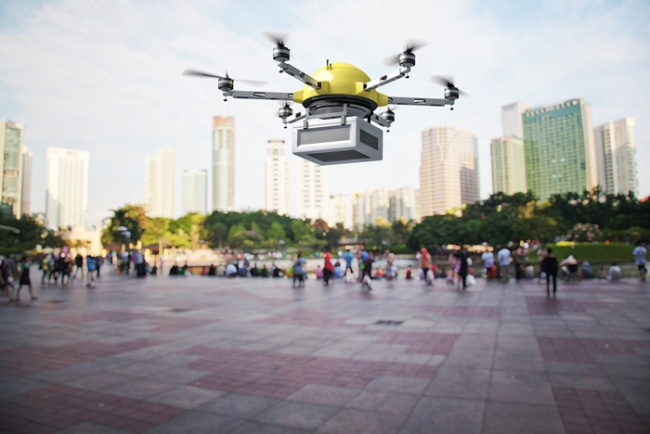[Weekender] Drones glide into life, homes and businesses
‘A drone allows me to see my surroundings like an angel, which would otherwise be impossible.’
By Korea HeraldPublished : June 19, 2015 - 21:09
Drones, or unmanned aerial vehicles, are penetrating everyday life, bringing with them changes and challenges.
Although they have only recently become widely used, the basic technology that goes into creating a drone was first developed in the early 20th century.
Through decades of research, the U.S. military was able to deploy drones during the Vietnam War and increasingly advanced and deadlier versions have carried out precision bombings in recent years, if with mixed results.
However, the days when the word “drone” referred mainly to military UAVs are slowly fading away.
While much less high-tech, and far from deadly, drone technology has embedded itself into very diverse areas of everyday life.
Companies like Amazon have taken up drones as a new delivery system, while camera drones have opened up entirely new angles for video media producers.
Although they have only recently become widely used, the basic technology that goes into creating a drone was first developed in the early 20th century.
Through decades of research, the U.S. military was able to deploy drones during the Vietnam War and increasingly advanced and deadlier versions have carried out precision bombings in recent years, if with mixed results.
However, the days when the word “drone” referred mainly to military UAVs are slowly fading away.
While much less high-tech, and far from deadly, drone technology has embedded itself into very diverse areas of everyday life.
Companies like Amazon have taken up drones as a new delivery system, while camera drones have opened up entirely new angles for video media producers.

Even news organizations have embraced drones as a novel way to collect information. Earlier this month, China’s Xinhua News Agency launched what has been dubbed the “drone reporters corps” by the Korean media.
The state-run agency plans to use drones to collect video footage and information on weather, which will then be used in making news stories.
However, the biggest change to take place in the drone market is the rise in drones for recreational use.
“To be really honest, I bought a drone just because it seemed like a cool idea,” said Chung Won-jae, a 35-year old office worker who began flying drones a few months ago.
“Then I got sucked in. A drone allows me to see my surroundings like an angel, which would otherwise be impossible, and there are so many types out there that it has become almost an obsession.”
From the toy-like rudimentary drones to others fitted with professional grade cameras, a huge range of drones are on offer. As drone technology advances, there are now even models like the Hexo+ that autonomously follow and capture images of the user.
The way drones are marketed has also changed.
Drones were once marketed largely through online shopping services, but now they are readily available at offline stores, including large retail outlets such E-mart, some of whose branches have seen double-digit sales growth this year.
There is, however, a darker side to the popularity of drones.
The rapidly rotating blades of the drones’ propellers pose a significant threat to the unwary, and drones have been compared to “flying lawnmowers” by some enthusiasts, highlighting the injuries drones can potentially cause.
The physical danger drones pose was clearly demonstrated in front of thousands of concertgoers recently when singer Enrique Iglesias sustained serious injury to his hand when he grabbed a drone on stage.
However, perhaps the more serious issues surrounding drones are those regarding privacy and their potential use in terrorism and other criminal activities.
In a development that prompted Japanese authorities to seek tougher drone regulations, 40-year-old Yasuo Yamamoto flew a drone carrying a small amount of radioactive material onto the roof of Prime Minister Shinzo Abe’s office.
After his arrest, he revealed that he was protesting against the Abe administration’s plans to restart old nuclear reactors.
With drones becoming increasingly affordable, camera drones have become a potential tool for the paparazzi and others hoping to take sneaky snaps even when the subject is within the walls of his or her home. Faced with such a possibility, the California government recently passed a law posing hefty penalties for those using camera drones to photograph somebody who is “under circumstances in which (they) had a reasonable expectation of privacy.”
Korea’s regulations regarding drones, however, remain far less sophisticated.
Existing regulations mainly deal with no-fly zones ― the airspace near the presidential office, military facilities and other areas concerned with security ― and size and flight altitude of drones.
By Choi He-suk (cheesuk@heraldcorp.com)
-
Articles by Korea Herald





![[KH Explains] No more 'Michael' at Kakao Games](http://res.heraldm.com/phpwas/restmb_idxmake.php?idx=644&simg=/content/image/2024/04/28/20240428050183_0.jpg&u=20240428180321)













![[Herald Interview] Mistakes turn into blessings in street performance, director says](http://res.heraldm.com/phpwas/restmb_idxmake.php?idx=652&simg=/content/image/2024/04/28/20240428050150_0.jpg&u=20240428174656)
